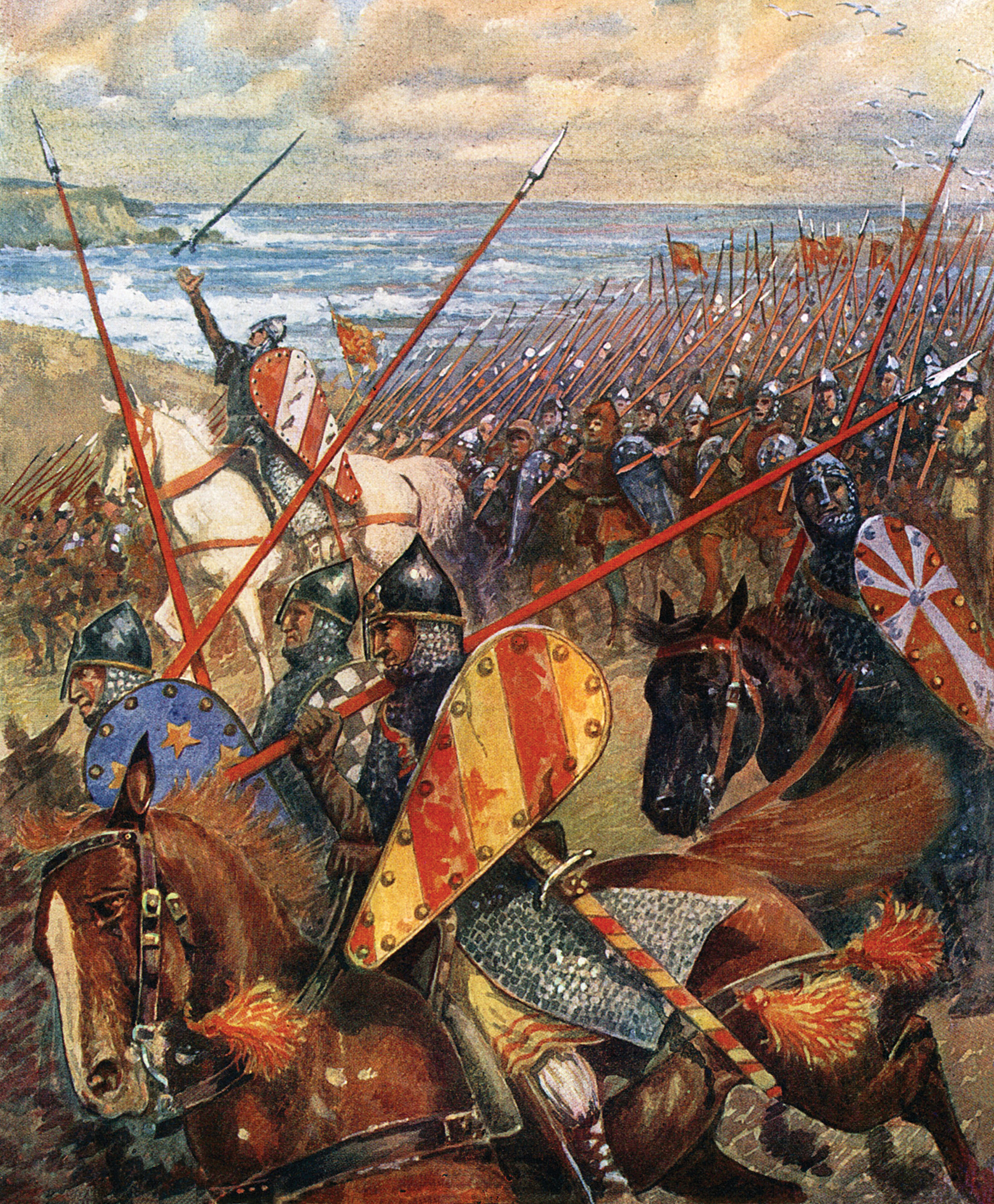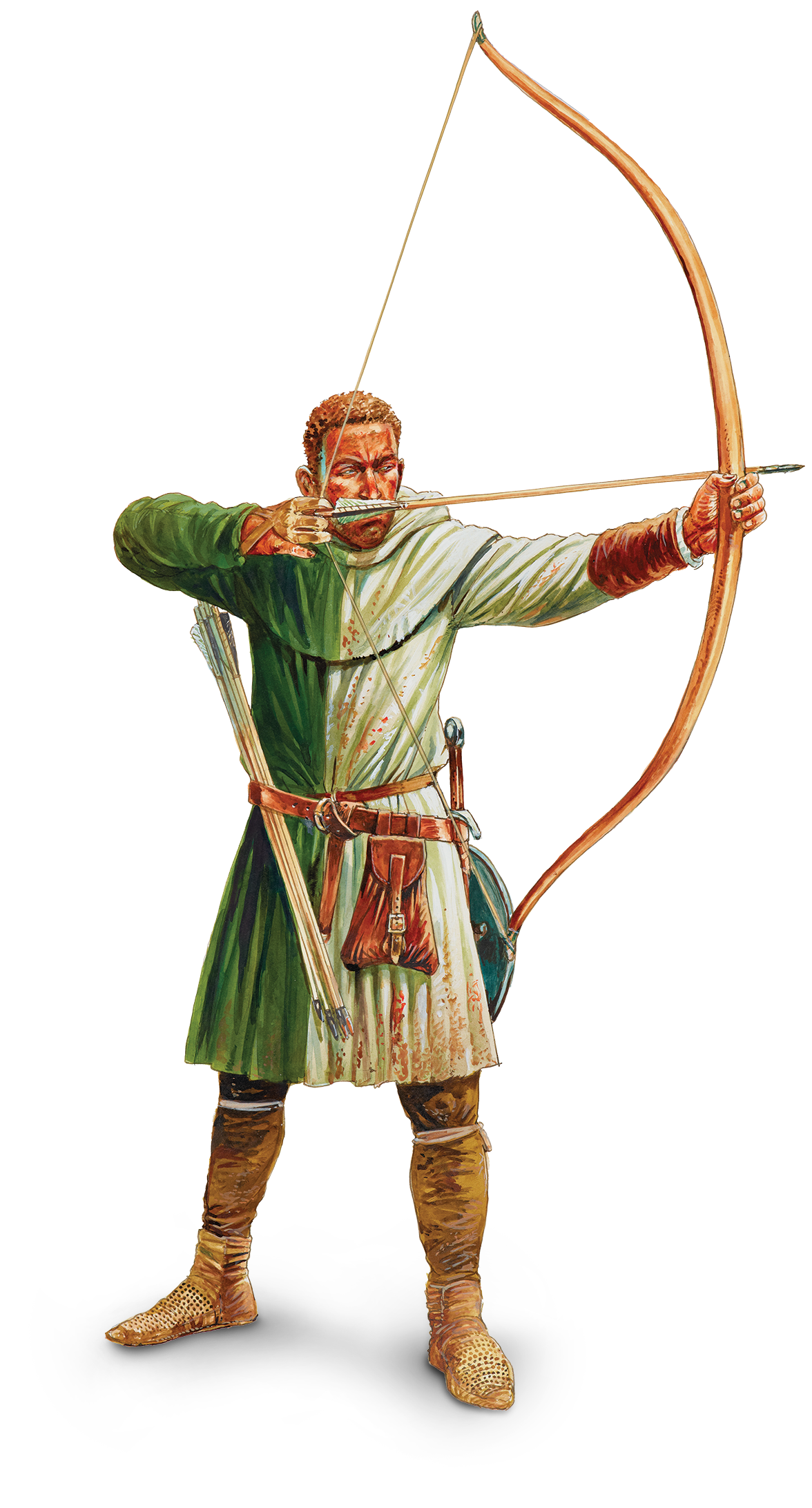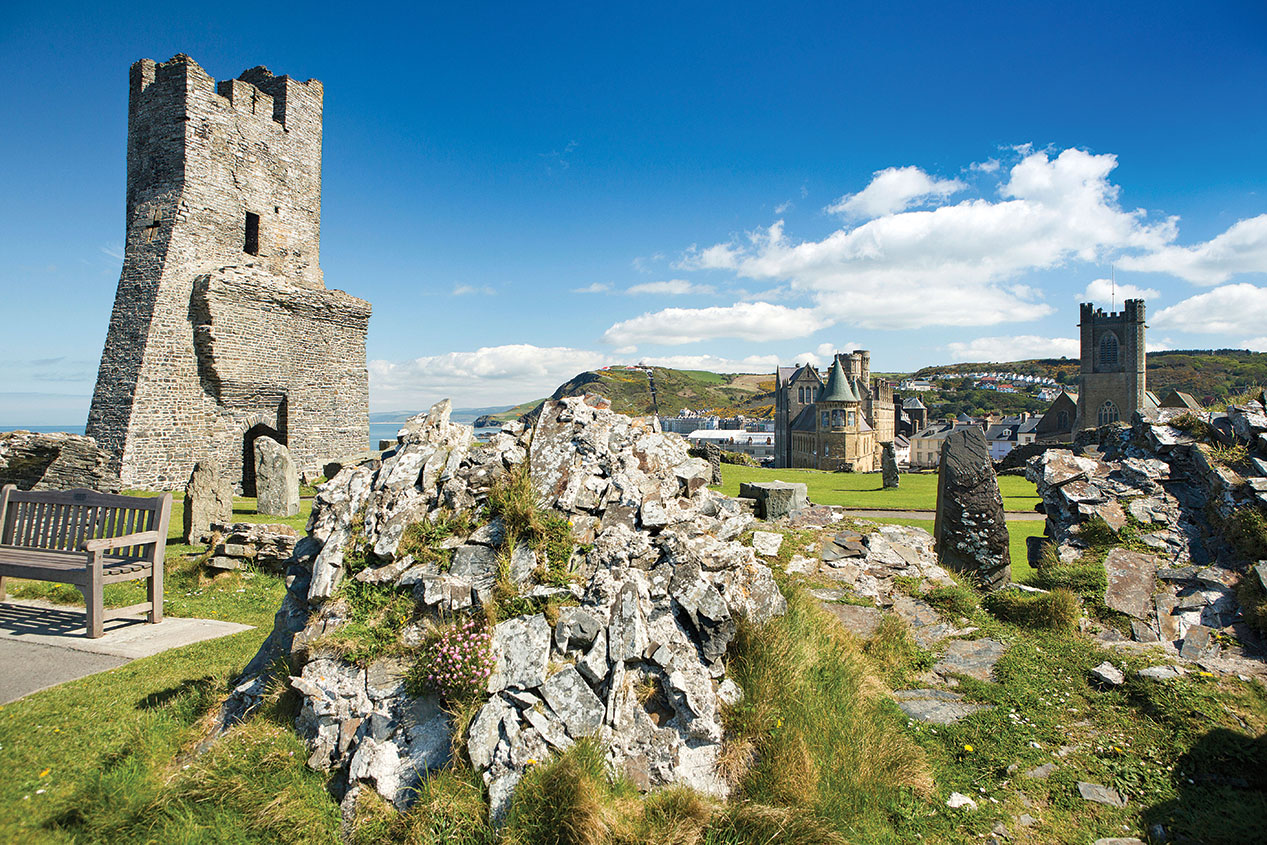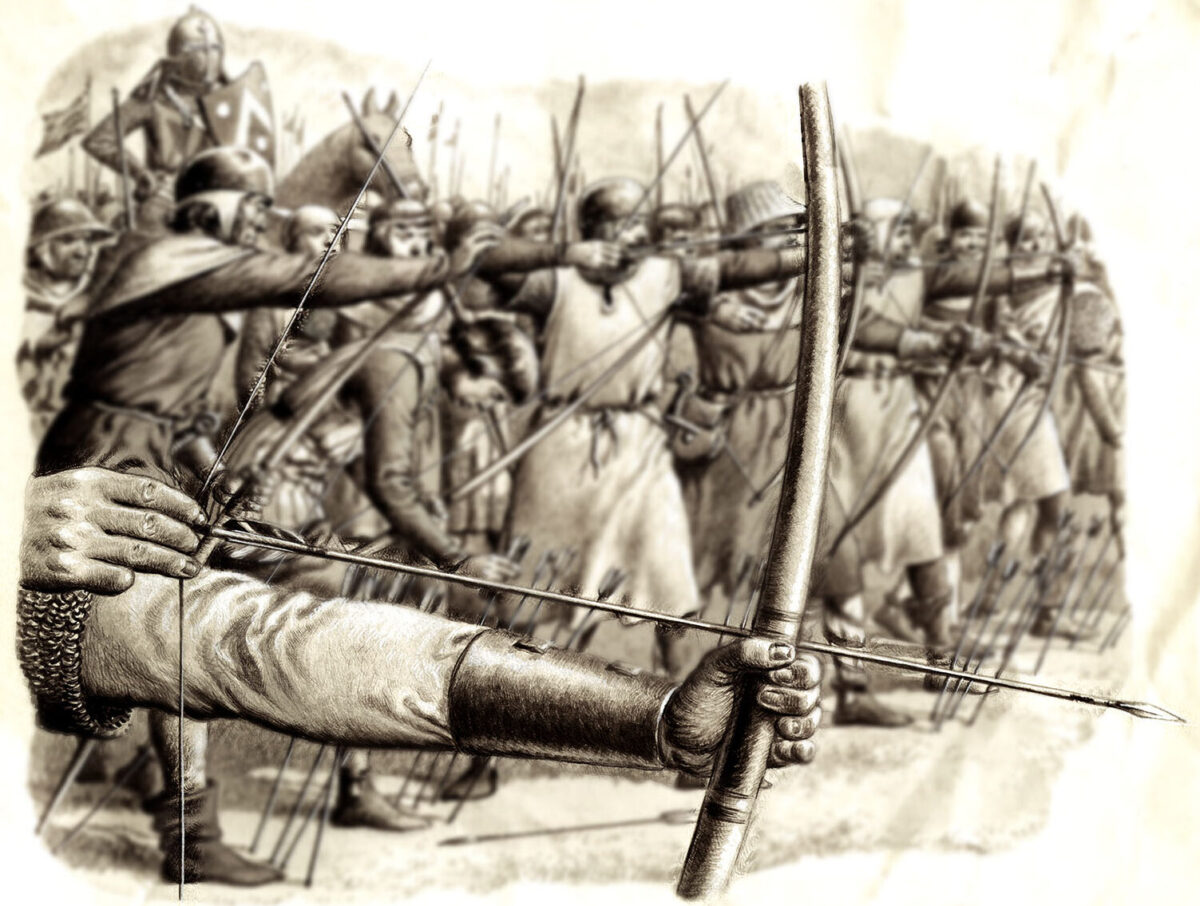In the autumn of 1136, high on a hill in the Welsh countryside some 2 miles northeast of Cardigan, Norman forces awaited the arrival of a 9,000-man Welsh army that had already taken several towns and sacked the only other Norman castle in the western realm of Ceredigion. Yet Norman commanders were confident of victory in the coming battle, certain they could crush the approaching Welsh with little effort.
Though comparable in numbers, the Normans had heavy cavalry, well-equipped infantry and the most ruthless Flemish mercenaries money could buy. Furthermore, they occupied the high ground, from which they could strike in any direction. What the Normans failed to appreciate, however, was the ability of Welsh commander Owain ap Gruffudd, the tenacity of his warriors and, foremost, their lethal skill with the longbow.
In 1066 Anglo-Saxon England fell to the Normans. Over the next several years William the Conqueror subdued the holdouts, gave their lands to his loyal followers and built strongholds across England. He then set his sights on the Celtic realms of Scotland, Ireland and Wales.
Like the Anglo-Saxons before them, the Normans considered the Celts an unsophisticated people, simple barbarians unworthy of regard. Yet by 1136 the Normans had gained only a foothold in the Celtic territory of Wales. Though Norman lords had either taken over or built castles in that untamed western frontier, they found it hard to “rule” in any true sense. The Welsh had never been fully subdued, either by political means or brute force, after successive Roman, Anglo-Saxon and Norman invasions. Frustrating Norman ambitions in the region were two major factors—topography and the framework of Celtic society.
The Welsh landscape is largely one of rolling hills and, at that point in history, vast, heavily timbered forests. “Because of its high mountains, deep valleys and extensive forests, not to mention its rivers and marshes, it is not of easy access,” observed 12th-century historian Gerald of Wales, archdeacon of Brecon, in South Wales. Such terrain made a far from ideal battleground for the heavy cavalry on which the Normans relied.
As was the case in other Celtic societies, the Welsh had no central government. They composed a patchwork of small, fluid kingdoms ruled by various lords, princes and kings whose fealty was fickle. Loyalties often changed at a moment’s notice, sparking regular infighting.
Like much of medieval Britain, Wales was land rich and cash poor. Its agrarian society was dominated by farmers and shepherds who supplemented what they could produce with hunting and foraging. That lifestyle, out of necessity, made them equally proficient with the bow and the sling. It also set the stage for the Welsh style of fighting. Facing the enemy on rocky ground often surrounded by marshes, Welsh warriors harassed larger forces from the distance of a stone’s throw or an arrow’s flight.

As a reward for their service William had granted lands to barons in Norman-controlled territory along the Welsh border. Ambitious for power, these nobles steadily encroached on adjacent Celtic kingdoms, mainly in South Wales. Welsh ambushes and raids slowed but didn’t stop the trespassers, who built castles and market towns, encouraged English settlement and married into princely Welsh families. The barons became known as “Marcher Lords.” Though the term derives from the root word “march,” meaning borderland, the Marchers may as well have been named for their tendency to simply march into areas they coveted, often without the leave of the English king.
Holding out against the Norman land grab were princes in three Welsh kingdoms—Gwynedd, in the northwest; Deheubarth, in the southwest; and Ceredigion, in between. To address these obstreperous Celtic realms, the Norman barons resolved to divide and conquer.
In 1093 Roger de Montgomery, one of William’s principal counselors, established an earthwork castle and town of Cardigan along the tidal reach of the River Teifi on the border of Ceredigion and Deheubarth. When Roger died the following year, the Welsh razed the fort and reassumed control. In 1110 Henry I, William’s fourth son and second successor, installed Marcher Lord Gilbert de Clare over Ceredigion. Basing himself in Cardigan, Gilbert built a timber forerunner to the present castle. Over the following two decades the Normans and the fiercely independent people of Ceredigion maintained an uneasy peace, kept in check by the Norman garrison stationed at the castle.
Henry’s own 1135 death and the succession crisis it spawned transformed the Welsh frontier. With the threat of civil war looming over England, most Norman lords withdrew from Wales. Among those joining the exodus was Gilbert de Clare’s eldest son, Richard, who retired to family holdings in the English borderland while flattering Henry’s eventual successor, Stephen.
The Welsh took full advantage. First, in January 1136, Hywel ap Maredudd, a Welsh lord from the central realm of Brycheiniog, gathered an army and raided Norman castles on the Gower Peninsula of Deheubarth, defeating them at the Battle of Llwchwr (northeast of present-day Swansea). Hearing news of the Welsh revolt, Richard de Clare marched west with a small force, determined to end the rebellion. But the Welsh got wind of his plans, ambushing and killing the presumptuous heir on April 15, 1136, near Llanthony Priory in the Brecon Beacons range of South Wales.
The Marcher’s death prompted the Welsh of Gwynedd to join forces with their Ceredigion brethren in expelling the Normans. By then widely regarded Prince Gruffudd ap Cynan of Gwynedd was in his 80s and losing his sight, so his sons Owain and Cadwaladr ap Gruffudd took up the banner and led the Welsh force south from Gwynedd. En route they took Landbadarn and Llanfihangel and sacked the castle at Aberystwyth, leaving Cardigan as the last remaining Norman fortress in Ceredigion.
The stage was set for a clash of wills at Crug Mawr.
Though the numbers of fighting men on each side were comparable, their makeup was decidedly different. Led by Welsh Marcher Lords Robert fitz Martin, Robert fitz Stephen and Maurice FitzGerald of Deheubarth, the Norman army comprised 1,000 Flemish mercenaries, 7,000 Norman infantrymen from local levies and 2,000 horse, much of which was heavy cavalry. The combined Welsh army—representing Gwynedd, Deheubarth and the eastern realm of Powys—comprised 6,000 infantry (mainly spearmen), 2,000 longbowmen and 1,000 light cavalry. Leading them were Owain and Cadwaladr ap Gruffudd of Gwynedd, Prince Gruffudd ap Rhys of Deheubarth and a host of subcommanders, each responsible for the men from his region.
Under normal medieval battle conditions an observer might assume, as did the Norman commanders, the Normans would have the upper hand. Their forces were better trained, better equipped and had the advantage of heavy cavalry. The tanks of medieval warfare, these armor-clad riders and mounts were designed to break up infantry formations and spread fear and chaos. Norman belief in their own tactical superiority—and their preconceived ideas about Welsh inferiority—led them to seriously underestimate their enemy.
What the Welsh lacked in experience and equipment, they compensated for in ferocity, resolve and a firm tactical grasp of their home ground. Having herded sheep over the hilly terrain and hunted the forests for centuries, they knew the landscape and how to exploit it to their advantage. Though their horses lacked the bulk and armor of their adversary’s heavy cavalry, their mounts could maneuver far more quickly in combat. The Welsh had another ace up their sleeve—the longbow.
While all Welshmen were familiar with the longbow, having used it to hunt game and defend their flocks from predators, the archers of South Wales had perfected its use as an instrument of war. “The people of Gwent, in particular, are more skilled with the bow and arrow than those who came from other parts of Wales,” wrote 14th-century Welsh bard Iolo Goch.
Though the Welsh perfected its use, they did not invent the longbow. Its basic design had been around for millennia, the earliest example from continental Europe dating from 3300 bc. In capable hands the longbow is extremely accurate at close range, and as an artillery weapon it can rain down armor-piercing projectiles from an effective range of up to 250 yards.
“The bows they use are not made of horn, nor of sapwood, nor yet of yew,” Iolo noted. “The Welsh carve their bows out of the dwarf elm trees in the forest.”
The website WarbowWales.com notes longbows were made from common and wych elm. Gerald described them as “ugly, unfinished-looking weapons, but astonishingly stiff, large and strong, and equally capable of use for long or short shooting.”
As they used their longbows primarily to hunt, Welsh archers were adept at hitting targets on the run. That said, hunting deer is far different than facing armed men afoot or on horseback, many of whom would be wearing chain mail or even full armor. To pierce even the stoutest mail, Welsh archers used a square-sectioned arrowhead known as a bodkin. When training for long-distance shooting, archers shot at “butts,” or earthen mounds, set out at about 220 paces.

While the Normans were doubtless aware of the effectiveness of the longbow, the extant histories of Crug Mawr make no mention of bowmen among their forces. Perhaps they grouped their archers under the general term “infantry,” though it’s possible their absence was a further sign of Norman disdain for the Welsh.
The Normans at Cardigan were apparently aware of the Welsh force as it approached from the north on the day of battle. Emerging from the castle, the Normans marched out 2 miles to Crug Mawr (Welsh for “Great Hill”), high ground overlooking the road from Aberystwyth.
The Normans deployed in three lines—the crack Flemish troops out front with Norman infantry in reserve and the cavalry in the rear. Commanders hoped to entice the presumably undisciplined Welsh to attack uphill. Any who survived the Flemish onslaught were to be ridden down by the Norman cavalry—a tried-and-true tactic that had proven successful in continental warfare. But as the Normans were soon to discover, Wales was not the Continent.
With Owain ap Gruffudd at the fore, the Welsh advanced down the road to Cardigan at a deliberate, yet cautious, pace. Spotting the Norman army atop Crug Mawr, Owain immediately understood their deployment. Calling a halt, he had the Welsh subcommanders move most of their infantry to the center with the cavalry protecting their flanks. The remaining infantry were held in reserve. Owain put his archers on the front line, then resumed the march.
Refusing to take the bait and attack uphill, Owain halted his line some 200 yards from Crug Mawr and had his archers launch a storm of arrows into the frontline ranks of armored Flemish mercenaries. With each volley the bodkin-tipped Welsh shafts inflicted costly losses the Normans could ill afford. Sent forward to fill the gaps, the largely unarmored Norman reserve infantry suffered even greater casualties.
To stem the spreading panic, Norman commanders sent their heavy cavalry forward to break the enemy line. The Welsh bowmen responded by simply turning their attention, and their aim, against the new threat. A wall of arrows slammed into both riders and horses—after all, a horse is simply a larger target, and a cavalryman without a horse is just infantry. Volley after volley mowed down men and their mounts. By the time the remnants of the Norman heavy cavalry reached the Welsh lines, the momentum of their charge was all but spent.
As the Norman cavalry approached, the bowmen retreated behind the infantry, which threw up a curtain of spears. Having lost all speed and the advantage, the armored Norman riders and horses were unable to break through. As the attack stalled, the Welsh cavalry charged in from both flanks, catching the Normans in a modified pincer movement. Harried on either side and blocked by the Welsh infantry, the Norman cavalry had no choice but to break contact and retreat. But instead of retreating to their own lines and regrouping to make a stand against the Welsh—or at least making an orderly withdrawal—the cavalrymen fled down the Cardigan road, leaving their infantryman wholly exposed.

On witnessing their heavy cavalry break and run, the surviving Normans and Flemings soon followed their lead. Theirs was no orderly retreat. Had it been, they might have stemmed their losses. Instead, the frantic foot soldiers proved easy game for the Welsh light cavalrymen, who chased them south toward Cardigan and the River Teifi.
Under the weight of so many armored men and horses, the bridge across the Teifi soon collapsed. While some men managed to strip themselves of their armor and weapons and make it across, many more were stranded on the near side and quickly slaughtered by the Welsh. Accounts describe the river as being clogged with the bodies of men and animals. Normans and Flemings not able to make it back inside the castle walls sought sanctuary in the surrounding village, but the Welsh soon burned it to the ground.
Those Normans fortunate enough to make it back inside Cardigan Castle were spared, as their pursuers didn’t have the forces or siege engines to take the fortress. But the battle had been a decisive victory for the Welsh. Of the estimated 10,000 Norman troops who took to the field that day, as many as 3,000 were killed. The rest would live to fight another day, though not until the reign of Edward I (1272–1307) would the English gain some measure of control over the Celtic rebels on Britain’s western frontier.
Dana Benner is a frequent contributor to Military History. For further reading he recommends A Great and Terrible King, by Marc Morris, and the articles “Medieval Welsh Warriors and Warfare,” by Daniel Mersey (available online at CastleWales.com), and “Longbow: A Medieval Take on Long-range Artillery,” by Historynet research director Jon Guttman (available online at Historynet.com).
This article appeared in the July 2021 issue of Military History magazine. For more stories, subscribe here and visit us on Facebook:





